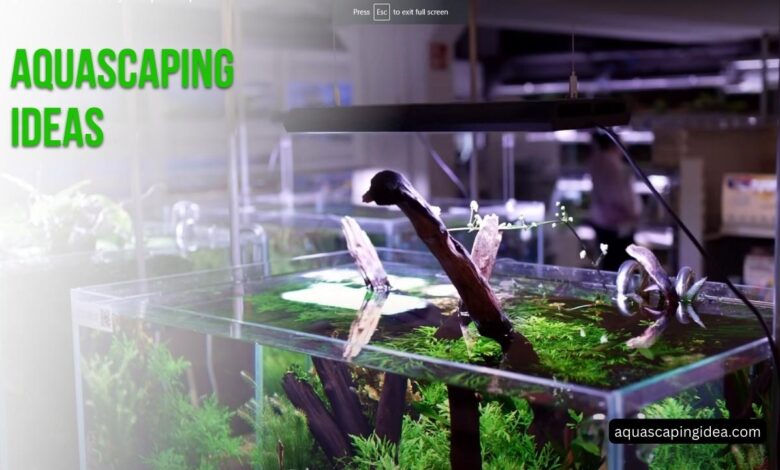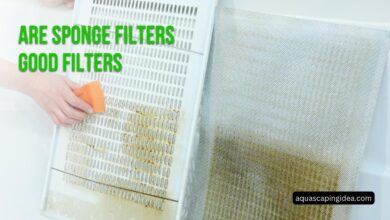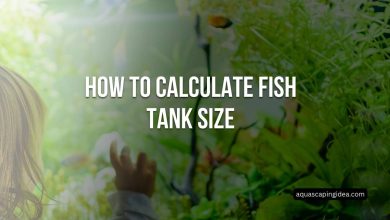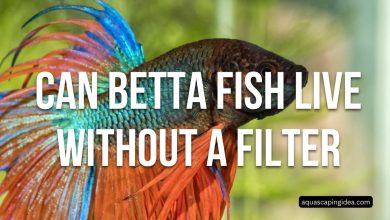Aquascaping Ideas for Beginners to Experts

What is Aquascaping Ideas?
Aquascaping involves artistically arranging aquatic plants, rocks, driftwood, substrates, and other hardscape elements to create stunning underwater layouts and visions of nature. The practice traces its artistic roots to ancient Chinese water gardens but has surged in popularity around the world over the last 25 years as a soothing hobby and competitive art form alike.
Today a vibrant global community of over 2.5 million aquascapers shares inspiration spanning sleek minimalist riverbeds to lush jungle vales. With the right guideance, anyone can unlock their creativity. This complete primer covers everything beginners need to get started as well as advanced design concepts for experienced aquascapers looking to perfect their craft. Let your imagination run wild and see where it takes you! The ocean’s the limit when it comes to aquarium landscaping artistry.
Fundamentals of Aquascaping Ideas
Good aquascapes artfully recreate vibrant underwater ecosystems in miniature while also simplifying maintenance with balanced biological filtration. But it takes careful planning as both visual art and living interior design.
Key technical considerations include:
- Tank Size & Layout Rectangular tank dimensions of 60cm+ height/depth suit most design needs
- Filtration & Circulation
Canister filters offer maximum mechanical + biological filtration capacity - High Intensity Lighting
LED or high output T5 with adjustable height to tailor intensity - CO2 Injection & Fertilization Pressurized CO2 with diffuser helps lush plant growth
- Aquatic Soil Foundation
Nutrient-rich substrate 1-2 inches deep supports root feeders - Hardscape Sculpture Positioned creatively prior to planting
By addressing fundamentals like filtration and lights first before adding hardscapes and plants, the underwater layout takes shape both beautifully and functionally.
Survey the Major Aquascape Styles
While creativity knows no limits, most aquarium landscapes embody one of several recognized composition styles that act as helpful starting blueprints:
Dutch Style – Symmetrical groupings of red, green & flowering plants Jungle Style – Lush variety replicating wild chaotic nature Iwagumi Style – Minimalist stone layouts w/ carpeting plants Island Style – Central focal peaks w/open sand swimming lanes Walstad Method – Low-tech natural soil planted tanks
Beyond form and plant palette, these layout archetypes convey different energies from high intensity jungles to serene simplicity. Once identifying personal style preferences, the fun truly starts building out seamless ecosystems from bottom substrate to surface tranquility.
Crafting Hardscape Masterpieces

Every eye-catching aquascape anchors itself around an artfully arranged hardscape foundation – intricately positioned stones, rows of weathered driftwood branches or clusters of seashells strategically placed to suggest mountain ridges, forest groves and sandy ocean floors with personality.
Popular hardscape materials include:
Here is a table of some popular hardscape materials used in aquascaping:
| Material | Description | Benefits | Considerations |
|---|---|---|---|
| Dragon stone | Forms dramatic overhangs and cliffs. Available in shades of tan, red, green | Visually striking. Creates dimension and levels. Allows planting in crevices. | Can affect water parameters initially. Heavy, difficult to shape. |
| Seiryu stone | Angular blue-grey stones with texture | Provides accent color and interest. Allows algae growth to enhance natural appearance. | Can raise pH and water hardness. Become brittle with time. |
| Lava rock | Lightweight porous volcanic rock | Can act as biofilter and allow beneficial bacteria to colonize. Adds interest and complexes cavities. | Can be too abrasive for some fish. Will need to monitor quality. |
| Mopani wood | Dense driftwood that sinks. Darkens with water. | Releases tannins appreciated by some species. Provides shelter and spawning sites. Interesting shape. | Will leach tannins that impact pH and water color. Not as durable as other driftwood. |
| River stones | Smooth, rounded cobblestones | Versatile, available in range of colors and patterns based on mineral composition | Not as dramatically shaped as other hardscapes. Limited positioning options. |
Group these raw elements based on odd-numbered principles for asymmetrical appeal – triangles, overlapping groups of 3, 5 or 7 pieces. Keeping lower in the front/sides for visibility while elevating focal points higher in the back directs perspective lines for added depth.
Though seemingly lifeless, inert hardscapes sculpt living spaces – caves for shy species to emerge from, ledges for epiphytes to cling onto and ridges diffusing water flow to prevent substrate erosion. Prime real estate for every inhabitant!
Curating Gorgeous Gardens of Green
The plant palette brings hardscape sculptures to life, as vibrant mosses creep across stony ridges while crimson stems burst from crevices framed by glossy leafed shrubs and delicate stem plants swaying in the current.
But tropical aquarium plant choices today now number over 1000 species – how to even begin choosing? Consider grouping selections by growth speed, maxiumn height and preferred placement:
Background Plants
| Plant | Height | Growth Speed |
|---|---|---|
| Vallisneria | 70-100+ cm | Fast |
| Hygrophila | 70-100+ cm | Fast |
Midground Plants
| Plant | Height | Growth Speed |
|---|---|---|
| Anubias | 30-70 cm | Slow |
| Cryptocorynes | 30-70 cm | Slow |
| Java Fern | 30-70 cm | Slow |
Foreground Carpets
| Plant | Height | Growth Speed |
|---|---|---|
| Monte Carlo | <15 cm | Medium |
| Dwarf Hairgrass | <15 cm | Medium |
| Marsilea | <15 cm | Medium |
Floating Plants
| Plant | Height | Growth Speed |
|---|---|---|
| Frogbit | Floats on surface | Fast |
| Salvinia | Floats on surface | Fast |
Advanced Aquascaping Techniques

Experienced aquascapers can further elevate layouts using advanced techniques like the dry start method, sloped substrates, specialized planters and trimming disciplines. Consider stepping up skills with:
Dry Start – Seal tank wrapped in plastic to sprout emerged growth faster from exposed roots/stems before filling
Slope Grade – Sculpt steeper backwalls with 2-3 inch differences in substrate heights relative to the front pane for added dimension
Terraces – Build layered platforms to accentuate height and compartmentalize species
AquaPlanters – Designate species own pots allowing rearrangement
Moss Walls/Trees – Affix sphagnum pinned to meshes/foams
Pruning – Strategically trim certain stems to encourage side shoots and condensed growth while thinning overgrowth to prevent one species from shading others
Rescaping – Rehaul aging layouts after 1-2 years revitalizing the underwater landscape over time
Let Imagination Guide Your Design
While mature aquascapes may suggest endless technical complexity, simply start doodling ideas using pencil and paper. Sketch out hardscape structures in relationship to imagined plant groupings until a balanced composition emerges to then recreate within your tank canvas adding realism.
Helpful design tips include:
- Triangulate stones/wood in natural shapes – leaning pieces against others looks more interesting than neatly stacking
- Surround focal points to frame within negative space rather than centering
- Transistion heights/scale of materials from small pebbles to massive rocks across the layout to better gauge depth
- Repeating certain plant species in multiple areas ties the design together
- Cluster species in groups of 3,5 or 7 plants rather than linear rows
However you choose to apply these fundamentals – embracing either highly structured Dutch precision or the wild randomness of jungle chaos – make the artistic process fun first and foremost! Accept that initial attempts may take some refining adjustments.
The journey of bringing any underwater garden landscape vision to life through creative experimentation lined with living greenery offers rewards outweighing the destination. Step up fearlessly to the glass canvas and let your inner Picasso shine through!
10 Best Aquascaping Ideas for Beginners
Aquascaping ideas involves artistically arranging aquatic plants, rocks, driftwood, substrates and other hardscape elements to create stunning underwater layouts and visions of nature. From island-themed oases to Dutch-inspired precision, the creative possibilities span far and wide. Here we detail 10 eye-catching aquascaping ideas perfect for first-timers yet infinitely customizable as skills advance, complete with breakouts of all the plants, hardscapes, costs and care involved with bringing each to life step-by-step. Let’s dive in!
The Island Style Layout (1)
This layout style utilizes elevated rock formations to suggest a lush island oasis centered in the aquascaped habitat. Ideal for beginning aquascapers, it lends itself to open foregrounds and midground sections. CC

Key Elements:
- Elevated Stones forming island mounts
- Tall background plants lining mounts
- Medium-height midground plants outward
- Short clump-forming carpets framing island
- Coarse gravel borders marking coves
Plants
| Location | Plants |
|---|---|
| Background | Valisneria, Ludwigia, Hygrophila |
| Midground | Anubias, Cryptocorynes, Java Ferns |
| Foreground | Monte Carlo, Lilaeopsis, Hydrocotyle |
Hardscape
| Item |
|---|
| Seiryu Stones or Spiderwood |
Filtration & Flow
| Item |
|---|
| Pair Power Filter with Inline CO2 |
| Position Powerhead 2x GPH |
Substrate & Ferts
| Item |
|---|
| Tropica Aquasoil |
| Thrive+ Liquid Ferts |
Tech Specs
| Spec | Details |
|---|---|
| Size | 60cm + tank dimensions |
| Light | High Output, 8hrs+ with ViewPoint Ramp Timers |
| CO2 | Inline Injection at 4-6 bubbles per sec |
| Temp/pH | 72-80°F, pH 6.5-7.5 |
| Est. Cost | $250-500USD |
Dutch Style Symmetry (2)
Characterized by symmetrical groupings of red, green and flowering varieties precisely manicured into evenly spaced rows, the Dutch Style hass come to define the “Pride and Joy” competitive display benchmark for patient aquascapers. Requires advanced discipline with a keen eye for visual balance.

Key Elements:
- Strictly Manicured Rows & Tiers
- Red, Green, Colorful Mixed Stems
- Goldfish or Tetra Footprints
- Rock/Wood Frames Window Panes
Plants
| Category | Plants |
|---|---|
| Background | Hygrophila, Rotala, Ludwigia |
| Midground | Staurogyne, Ammania, Bacopa |
| Foreground | Glossostigma, Monte Carlo, Marsilea |
Hardscape
| Item |
|---|
| Dragon Stone or Driftwood Branches |
Filtration & Flow
| Item |
|---|
| Canister Filter + Inline CO2/Heater |
| Circulation Pump for GPD turnover |
| Auto Doser w/ Micro & Macro Solution |
Substrate & Ferts
| Item |
|---|
| ADA Amazonia |
| PPS Pro Fertilization Method |
Tech Specs
| Spec | Details |
|---|---|
| Size | 120cm+ tanks recommended |
| Light | High Output LED, 8-10hrs w/ Midday Burst |
| CO2 | Pressurized Injection, 1 Bubble per sec minimum |
| Temp/pH | 73-78°F, pH. 6.2-6.8 |
| Est. Cost | $1000-3000 USD |
Minimalist Iwagumi (3)
Clean, minimalist iwagumi stonework layouts with low carpeting plants evoke serenity, carefully balancing just a few elements guided by the Rule of Thirds position and negative space use. Transcend complexity focused on simplicity at its finest.

Key Elements:
- Stonework Triangles or Lines
- Low Carpeting Plants
- Negative Space
- Small Colored Tetras or Shrimp
Plants
| Category | Plants |
|---|---|
| Carpets | Monte Carlo, Baby Tears, Lilaeopsis, Marsilea |
| Accents | Anubias Nana, Java Fern, Moss |
Hardscape
| Item |
|---|
| Seiryu Stone, Pea Gravel |
Filtration & Flow
| Item |
|---|
| Canister w/ Inline CO2 Diffuser |
| Circulation Fan Directed Sideways |
Substrate & Ferts
| Item |
|---|
| Tropica Growth Substrate |
| Thrive Liquid Ferts |
Tech Specs
| Spec | Details |
|---|---|
| Size | 60cm Long Tanks recommended |
| Light | LO LED or T5HO, 6-8hrs duration |
| CO2 | Pressurized, Low 5 bubbles/sec rate |
| Temp/pH | 72-78°F, pH 6.5-7.0 |
| Est. Cost | $750-1500 USD |
Lush Jungle Valleys (4)
Nothing conveys the lively essence of the thriving tropics better than a wild jungle aquascape packed full with a luscious variety of leaf shapes, sizes and vibrant green hues. Allow nature-mimicking epiphytic plant growth flourish!
Key Elements:
- Wild Overgrowth Appearance
- Variety of Leaf Shapes
- Mixed Heights & Density
- Driftwood/Twisting Roots
Plants
| Plants |
|---|
| Bucephalandra Clumps |
| Bolbitis Balls |
| Java Moss Bushes |
| Cryptocoryne Clubs |
| Anubias Islands |
| Rotala Rows |
Hardscape
| Item |
|---|
| Spiderwood, Manzanita, Seiryu Stone |
Filtration & Flow
| Item |
|---|
| HOB Power Filter & Circ Pump |
| Additional Surface Movement |
Substrate & Ferts
| Item |
|---|
| Brightwell Aquatics Florinvol |
| Seachem Root Tabs |
Tech Specs
| Spec | Details |
|---|---|
| Size | 40 Gallon Breeders work well |
| Light | LED, 8-10 hour w/ Midday Burst |
| CO2 | Optional for lower light setups |
| Temp/pH | 76-82°F, pH 6.8-7.5 |
| Est. Cost | $350-950+ USD |
Mossy Tree Stumps (5)
Recreate miniature mystical forests with gnarled branches and aged tree stumps slowly being consumed by invasive carpets of spongy emerald green mosses. Allow weeks to fully encase hardscape in the fluffy greenery for haunting effects.
Key Elements:
- Detailed Spiderwood Sculptures
- Christmas Moss attached to branches
- Attached Riccia for aerial effect
- Carpeting Java Moss below
- Small schooling fish
Plants:
- Spiky Moss
- Christmas Moss
- Peacock Moss
- Java Moss
- Riccia Fluitans
Hardscape
| Item |
|---|
| Spiderwood Branches |
Filtration & Flow
| Item |
|---|
| HOB Power Filter |
| Small Nano Canister Filter |
| Circulation Pump |
Substrate & Ferts
| Item |
|---|
| Controsoil Substrate |
| ADA ECA / Equilibrium |
Tech Specs
| Spec | Details |
|---|---|
| Size | 10-20 Gallon Nano Tanks |
| Light | Moderate LED 8hrs |
| CO2 | Optional at <15 Gallon |
| Temp/pH | 72-78°F, pH 6.8-7.2 |
| Est. Cost | $300-600 USD |
Natural Driftwood Caves (6)
Play with dimension and depth carving out negative spaces with uniquely positioned branches stacked horizontally to form intimate hideaways and tunnel-like pathways for species to claim their sheltered territories. Dare them to explore!
Key Elements:
- Horizontally Layered Branches
- Carpeting Plants in Fore/Background
- Open Swimming Midground
- Shrimp & Small Community Fish
Plants
| Category | Plants |
|---|---|
| Carpets | Dwarf Hairgrass, Marsilea |
| Midground | Java Fern, Anubias |
| Background | Cabomba, Hornwort |
Hardscape
| Item |
|---|
| Manzanita Branches & Malaysian Driftwood |
Filtration & Flow
| Item |
|---|
| HOB Power Filter |
| Small Circulation Pump |
Substrate & Ferts
| Item |
|---|
| ADA Malaya / Africana / Similar |
| Root Tabs |
Tech Specs
| Spec | Details |
|---|---|
| Size | 20 & 30 Gallon Long Tanks great |
| Light | Moderate LED 7-9 hrs |
| CO2 | Optional DIY Yeast Method |
| Temp/pH | 74-80°F, pH 6.6-7.5 |
| Est. Cost | $400-750 USD |
Dutch Street View (7)
Frame the underwater scene like peering down a canal at houseboat clusters competing for the best moss gardens to pretty rows of canal plants submerged save for frilly short emergent stems. Eclectic whimsy yet orderly rows for behavioral observations.
Key Elements:
- Rows of Green Houses (Planters)
- Partitioned Species Sections
- Plentiful Swim Lanes
- Long Tanks Ideal
Plants:
- Mixed Stem Varieties per Section
- Moss Walls on Houses
- Dwarf Lilies & Marginals
Hardscape:
- Ceramic Planting Pots
- Stone/Driftwood Planter Partitions
Filtration & Flow Needs:
- Canister Filter
- Powerhead for Flow
Aquasoil & Ferts:
- Controsoil/similar
- Osmocote+ Root Tabs
Tech Specs
| Spec | Details |
|---|---|
| Size | 50-120 Gallon Long Tanks |
| Light | LED High 8-10hrs |
| CO2 | Pressurized; 2-4 Bubbles/sec |
| Temp/pH | 72-80°F, pH 6.5 to 7.5 |
| Est. Tank Cost | $800-2000+ USD |
Seascapes with Coral (8)
Marine aquarium keepers can emulate the colors and textures of an ocean reef with cut coral skeletons for small polyp stony corals or soft branching pieces to encrust like sea fans and rustic gorgonians with sweeping purple plumes when the mood strikes recreating ocean pinnacles.
Key Elements:
- Layered Aquacultured Live Rock
- Coral Fragments on Rocks
- Bright Illumination
- Strong Circulation
Corals:
- Zoanthids
- Palys
- Candy Cane
Hardscape:
- Caribsea Life Rock
- Macro Rock Rio Grande Gold
Filtration & Flow Needs:
- Protein Skimmer
- Strong Circulation Pump
Substrate & Supplements:
- Crushed Coral Sand
- 2-Part Coral Nutrient Systems
Tech Specs
| Spec | Details |
|---|---|
| Size | 30 Gal Cube or Larger |
| Light | VHO T5, Metal Halide, or LED |
| CO2 | Not needed |
| Temp/pH | 78-82°F; pH 8.1 to 8.4 |
| Est. Tank Cost | $2000+ USD |
Flexible Stem Forests (9)
Densely planted thickets exclusively mixing varieties of Rotala, Ludwiga and Ammania create intense focal thickets of color where pruned stem tops continuously bush out horizontally layering into treetop canopies with lighter feathered foiliage underneath in a modern constantly evolving interpretation merging the best of both Dutch and Jungle styles.
Key Elements:
- Exclusively Stem Plants
- Treated as Seasonal Design Element
- Aggressive Trimming
- Accent Twigs or Stones
Plants:
Rotala Green Ludwigia Red Ammania Gracilis
- Other Red/Orange/Purple Stems
Hardscape:
- Ohko Stone
- Spiderwood Twigs
Filtration & Flow Needs:
- Canister Filter
- Inline CO2 Atomizer
- Powerhead for Flow
Aquasoil & Ferts:
- UNS Controsoil
- Thrive Liquid Fert & Root Tabs
Tech Specs
| Spec | Details |
|---|---|
| Size | 20+ Gallon Long |
| Light | High Output 8-10hr Photo Period |
| CO2 | Pressurized; Higher 30ppm+ |
| Temp/pH | 72-80°F; pH 6.5-7.0 |
| Est. Tank Cost | $500-1000+ |
Dutch Amano Inspired (10)
No aquascaper carries as much legacy clout as Japanese legend Takashi Amano – founder of ADA brand goods, artistic pioneer blurring the lines between aquarium gardening and legitimate fine art photography with his worldwide influences still reigning strong today. Pay homage by taking inspiration from any of his hundreds of beautifully curated Dutch layouts over the years as the consummate professional.
Key Elements:
- Rule of Thirds Hardscape Framing
- Carpeting Foreground
- Red Mixed Stems Midground
- Green Background
- Precise Trimming!
Plants:
- See 2. Dutch Style Symmetry Examples
Hardscape:
- Seiryu Stone
- Driftwood
Filtration & Flow Needs:
- ADA Canister Filters
- Pollen Glass Beetle CO2
Aquasoil & Ferts:
- ADA System Package
Tech Specs
| Spec | Details |
|---|---|
| Size | 60cm Standard per ADA |
| Light | ADA Solar RGB LED |
| CO2 | Pressurized ADA System |
| Temp/pH | 72-78°F; pH 6.4-6.8 |
| Est. Tank Cost | $1500-4000+ USD |
Last Word of 10 aquascaping concepts
Recreating any of these 10 aquascaping layouts showcases the diversity possible with this relaxing hobby that neatly fuses interior design with living artwork. Just take that first step planning out aquatic plant groupings anchored around hardscape centerpieces specially chosen to convey distinct energies from tranquility to high intensity. Let your imagination run wild and see where it takes you! The ocean’s the limit when it comes to aquarium landscaping creativity.
Frequently Asked Questions
What types of fish or shrimp best complement planted aquascape tanks?
For beginners, hardy tetra species like Cardinal Tetra and community favorites like Pearl Gourami or Dwarf Gourami make excellent centerpiece fish that peacefully school in planted surroundings. Red Cherry Shrimp populate nicely without disrupting deliberate designs.
Do I need to inject pressurized CO2 into the tank?
While not essential for easy plants like Anubias/Java Fern, adding CO2 benefits faster growing stems. Start with DIY yeast-based methods before upgrading to pressurized systems for tanks over 20 gallons if pursuing high intensity Dutch-inspired designs demanding lush carpets.
How many hours should I leave tank lights on daily?
Balance lighting durations to avoid promoting excess algae. Start conservatively with just 6-8 hour photoperiods while plants establish, slowly increasing to 8-10 hours maximum for high growth tanks. Always allow 4-6 hours of darkness nightly.
What fertilization is required, if any?
While aquasoils release some nutrients, liquid fertilizers or root tabs are vital to sustain healthy plant growth long term. Alternate micro and macro blends following label instructions. Excess iron can accumulate to toxic levels for inverts like shrimp if overfed.
Can I add aquatic pond plants like Lotus or Marginals?
Yes! Many aquatic pond plants like Taro grow well indoors adding unique tropical vibes. Plant in classification appropriate planters to keep crowns above water lines. Marginals like Arrowhead Vine grow directly emerged from riparium planters allowing trailing aerial roots underwater.
Conclusion:
Make Aquascaping Your Passion Hopefully this overview has sparked plenty of ideas envisioning your own underwater garden paradises! Aquascaping teaches patience through ever-changing plant growth cycles but rewards years of enjoyment curating balanced aquatic plant layouts. Just take that first step recreating inspiring designs simplified for beginners yet infinitely customizable as skills advance.
Soon you’ll look forward to losing whole weekends happily tending the underwater landscape! Once the aquascaping creativity bug bites, welcome to a new passion providing genuine mental health healing one trimmed stem at a time. Dive on in – your dream aquarium awaits!




